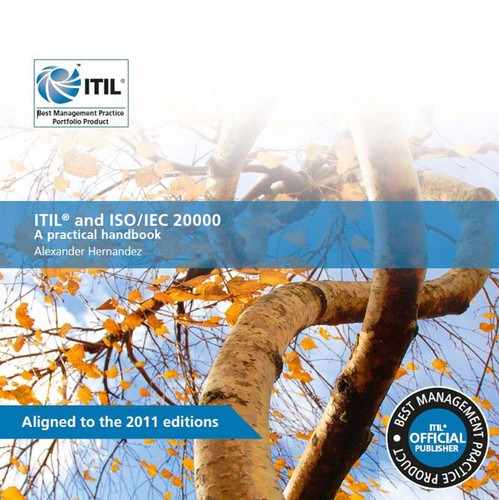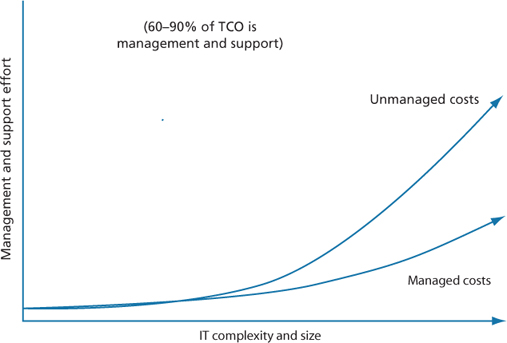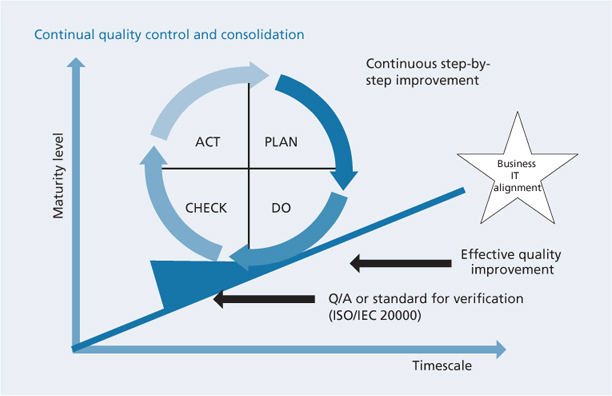1Defining business drivers to execute a service management system
1.1DRIVER 1: HOW ISO/IEC 20000 AND ITIL CAN IDENTIFY CUSTOMER NEEDS AND DELIVER VALUE
As businesses, we must never lose sight of the fact that the primary reason we are in business is because customers find value in our services. Ultimately, there is no reason for a business to exist without the customer. We must always keep our finger on the pulse of our customers’ needs, thereby building truly solid relationships with them. The discipline of service management helps an organization to understand customer requirements, centralize operations, standardize processes and reduce costs. If done properly, these supporting elements will assist organizations in achieving customer satisfaction, profitability and loyalty, as depicted in Figure 1.1. Customers are primarily interested in a service that is consistent, accurate, timely, cost-effective, quality-based and value-added.
The following quote from Peter Drucker provides a clear focus on services from the customer’s perspective:
‘Quality in a service or product is not what you put into it. It is what the customer gets out of it.’
Peter Drucker
It is important to keep in mind that there is more to the value of a service than just the function and cost of the service. Three main factors define the value of a service: business outcomes, customer preferences and the customer’s perception of what was delivered. Figure 1.2 from ITIL Service Strategy illustrates the triangle of value.
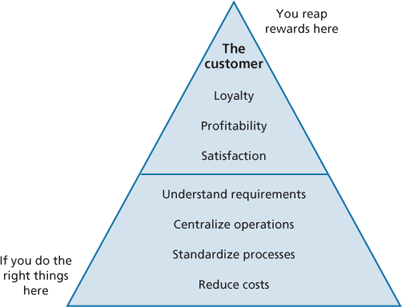
Figure 1.1 Focus on the customer
Perceptions are influenced by the attributes of the service and the customer’s expectations of the service. Customers use a reference point from either a past service experience or a similar service experience to assist them in measuring the value of the service. For example, you decide to purchase a new luxury vehicle at company XYZ, and in the past have purchased a luxury vehicle at company ABC. Since both vehicles fall in the luxury category, you expect to receive superb service on your new luxury vehicle based on your past ABC service experience. In addition, you expect the attributes of the service being provided to you by XYZ to be similar to the attributes provided when you owned a luxury vehicle from ABC, including free pickup of your vehicle for maintenance and free rental of a luxury vehicle while your vehicle is undergoing scheduled or unplanned maintenance.
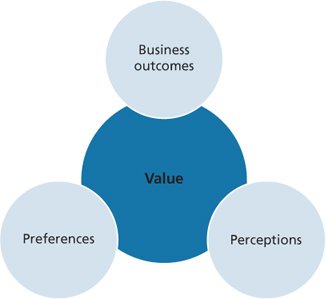
Figure 1.2 Factors that influence value
What is needed to deliver the customer outcomes? Resources and capabilities create value for the customer in terms of goods or services. Resources represent direct inputs for production. In the example above, the resources are the service department, sales personnel, company and customer information, financial capital, manufacturing plants and infrastructure supporting the organization XYZ. Capabilities involve coordinating, controlling and deploying resources to deliver value to customers. Capabilities are considered knowledge-intensive and experienced-based. It is important to note that capabilities are developed and enhanced over time through experience obtained by servicing customers, developing services and products, servicing contracts and servicing different market segments.
1.2DRIVER 2: HOW ISO/IEC 20000 AND ITIL CAN REDUCE UNPLANNED DOWNTIME
You may be asking yourself, ‘Why is service management so critical to supporting the business?’ Effectively implementing service management can significantly reduce the impact of planned and unplanned downtime. Downtime is a critical business issue for information technology. So what is the cost of downtime? One method that can be used to calculate downtime is the impact on gross revenue. This approach was originally designed for major network outages but can be customized for any priority 1 (major) outage. The calculation is determined by dividing the company’s gross annual revenue by the hours of operation. This will give a dollar value per business hour for the network’s availability. Multiplying this dollar value per hour by the number of hours of unplanned downtime in the past year will show the cost of downtime to the organization, as illustrated in the example in Table 1.1 (Netforcement, 2005).
Table 1.1 Cost of downtime for a company
Annual gross revenue |
$50,000,000 |
Business hours |
2,080 |
Revenue per hour |
$24,038 |
Unplanned downtime |
20.80 (hours) |
Downtime cost |
$500,000 |
The second area of measurement is the impact on employees or users of the IT service, as illustrated in the example in Table 1.2.
Table 1.2 Employee cost of downtime
Average employee salary |
$50,000 |
Cost impact is 35% |
$67,500 |
Cost per hour (divide by 2,080) |
$32.45 |
Unplanned downtime |
20.80 (hours) |
Downtime cost per employee |
$675 |
Number of employees |
100 |
Total employee cost of downtime |
$67,500 |
This approach can greatly simplify availability reporting and gain the much needed focus, funding and attention of business executives that is necessary to resolve or prevent availability issues.
1.2.1Impact of downtime
When considering whether or not to implement availability management and invest in measures to improve availability, it is important to consider the costs of unavailability. These are generally categorized into either tangible or intangible costs to an organization. Examples include:
- Tangible
- Lost revenue
- Business staff productivity
- IT staff productivity
- Goods and materials
- Legal and regulatory fines
- Intangible
- Goodwill
- Customer satisfaction
- Opportunity costs
- Brand equity
- Confidence in the business and IT
- Employee morale.
Events that can result in unplanned downtime include platform or environmental issues, application failures and operator errors. More importantly, the major cause of unplanned downtime is the introduction of unmanaged change into the IT infrastructure. Investment strategies are available to minimize or eliminate platform or environmental issues, application failures and operator errors.
1.2.2Platform or environmental issues
These types of events should not be taken lightly. The devastation wreaked by Hurricane Katrina really puts into perspective the impact a natural disaster can have on communities as well as businesses if they are not properly prepared to respond during the event. Other examples of platform or environmental issues would be hardware, network and operating system failures, and power outages. The investment strategy to address platform and environmental errors includes:
- Building redundancy in hardware components and network infrastructure through the use of clustering technologies, disk mirroring, storage area network (SAN) technologies and load balancing.
- Building redundancy through alternative power resources such as an uninterrupted power supply (UPS) and generator that support the organization’s critical systems. In addition, a mirrored hot standby site in an alternative location can serve as a risk mitigation to address a power outage scenario.
- Investing in service contracts with outside providers that can serve as contingency options for providing backup and recovery services. This option is excellent for recovering critical business functions if the primary business operation goes down.
- Monitoring of critical hardware and network services. This practice allows an organization to address possible hardware and network issues proactively, before an outage occurs.
- Most importantly, developing effective business continuity and disaster recovery plans that have been tested against various scenarios is required to keep critical business functions operating at a minimal level or better during a serious outage. These plans must ‘live’ through adequate organizational communication and training.
1.2.3Application failures
This downtime category refers to application failures resulting from the release of untested applications and changes into the production environment. The investment strategy to address these failures involves implementing effective service management processes. These include release management, change management, configuration management, problem management and application management.
1.2.4Operator errors
This downtime category refers to errors caused by a lack of procedures and policies, as well as a lack of training.
The investment strategy to assist in addressing operator errors includes implementing an efficient and effective organizational change strategy and service management processes, along with supportive training, policies and procedures to facilitate the transformation of the IT organization.
An organization can implement a holistic and sustainable service management system (SMS) through the pragmatic application of the ISO/IEC 20000 standard and ITIL framework. This will help in addressing the aforementioned common causes of unplanned downtime.
1.3DRIVER 3: HOW ISO/IEC 20000 AND ITIL CAN REDUCE TOTAL COST OF OWNERSHIP
Many executives express frustration as they attempt to rein in reactive events and expenses associated with their IT investments, but they find little in the way of substantive guidance. Taking a ‘full adoption’ service management approach versus a ‘no adoption’ approach can reduce an organization’s total cost of ownership (TCO) significantly. Figure 1.3 is an illustrative example of the possible increased management and support effort required when dealing with unmanaged costs as the IT environment increases in size and complexity. Another important point to realize is that 60–90% of the IT organization’s TCO is attributable to the management and support of the IT infrastructure.
Service economics can assist an organization to rein in costs by understanding the return on investment (ROI) for the service it is providing. This can be determined effectively by having robust financial management and service portfolio management processes. Financial management for IT services assists the organization in understanding the true costs of providing services. More importantly, it enables efficient and effective budgeting and accounting for all service costs. A service portfolio describes a provider’s services in terms of business value. The service portfolio clarifies the value the service is bringing to an organization when compared with services of a similar nature offered by competing providers.
A great example of a service where the ROI has always been a challenge is email. Today, many organizations are extremely dependent on email for their day-to-day business and communication. Why can’t we just use the old standbys for communicating, such as the telephone? Well, it’s not that simple. The beauty of email is that it can cross international boundaries and deliver written information and attachments in a matter of seconds, and it can manage tasks and schedules effectively across multiple time zones. Since so many critical organizational functions and tasks are dependent on email, an outage can cause losses of thousands of dollars per hour. For example, many email solutions have built-in calendar features, by which chief executive officers (CEOs) live and die. Without calendar access, executives could miss critical meetings and negotiations, generating a negative impact on multimillion-dollar deals and the organization’s future.
The biggest challenge with email is effectively performing a service-cost breakdown for email services by user or organizational department. Compare this to your local phone or cable service. With these, it is easy to get a cost breakdown of phone usage by the minute or by the cable offering purchased. The cost breakdown is sent back to the user or organization as a monthly charge in the form of a bill. So, why can’t we take the same approach for email? The primary reason many organizations have not been successful in this area is that they have not taken a services-based approach to IT provisioning.
Financial management for IT services and service portfolio management are the crucial elements in assisting organizations to grasp the true cost of providing email services. The first step in tackling this issue is to develop your messaging and collaboration offerings within the service portfolio. To effectively develop your service portfolio, you first have to understand what outcomes the customers are looking for in a messaging collaboration solution and which services the IT department within your organization is currently offering. You will want to address any identified gaps that exist between expected customer outcomes and current IT capabilities when finalizing your service portfolio. Based on your service portfolio, you now create a service catalogue with the description and accompanying details for each of the identified messaging and collaboration services and determine the associated costs of providing these services.
The service catalogue is the only customer-facing component of the service portfolio and includes information such as service description, prices and deliverables. For email, costs comprise people, accommodation, software, hardware, equipment and external services for providing messaging and collaboration. Once you have a good handle on the TCO for the provision of messaging and collaboration services, you will have a strong start towards creating a detailed service catalogue with a menu of offerings at associated price points. Taking this approach will provide a crisp and accurate service portfolio to help your organization to truly understand the value that IT brings to the customer and the business.
Implementing effective and efficient service management processes such as service portfolio management, service catalogue management and financial management can assist an organization in shifting from an unmanaged costs scenario (reactive) to a managed costs scenario (proactive). The ISO/IEC 20000 standard and ITIL framework provide significant guidance in measuring and ensuring effective service management. Service management is the catalyst that provides a disciplined approach to managing the IT function and integrating the IT function with the business.
‘However beautiful the strategy, you should occasionally look at the results.’ Sir Winston Churchill
1.4DRIVER 4: HOW ISO/IEC 20000 AND ITIL CAN PROVIDE A COMPETITIVE ADVANTAGE
An organization has a competitive advantage when the service it provides is superior to competing alternatives. Successful service strategies are primarily focused on taking advantage of your organization’s unique capabilities when delivering superior value to customers. How can you distinguish high-performing organizations? At the heart of these organizations is a synergistic balancing of the three core pillars of a high-performance strategy. These are:
- Distinctive capabilities This means that the organization is offering a unique service or product, providing a customer outcome that is very difficult to duplicate.
- Market focus An organization has market focus when it knows precisely what its current service or product offering entails. More importantly, it knows precisely who its customers are and what outcome the customer expects to receive from the product or service.
- Performance anatomy This is about staying ahead and being on the cutting edge of your service or product offering – always outperforming your competition. It is the relentless pursuit of perfection by looking at services as a strategic asset, increasing employee productivity, measuring selective key performance metrics and ensuring continual service improvement.
‘The essence of strategy is choosing what not to do.’ Michael E. Porter
The execution of these three core pillars within a high-performance strategy can alter an organization from a reactive to a proactive state, increasing its competitive advantage. The high-performance strategy also needs to consider the following four ‘P’ elements as part of its formula to achieve a competitive advantage: people, products/technology, partners/suppliers and processes, as illustrated in Figure 1.4 (taken from ITIL Service Design).

Figure 1.4 The four Ps
- People In general, people are transient, meaning that they can leave a job or organization whenever they wish. In addition, people usually have similar skills and talents, which can make it difficult to differentiate one individual from another when it comes to the roles and responsibilities performed by these individuals in the organization. However, having a talented workforce with unique skills supports the high-performance-strategy pillars of performance anatomy and distinctive capabilities.
- Products/technology In general, products and technology are not strong differentiators, since they have become increasingly commoditized. Today, organizations can generally access the latest and greatest technology for comparable market prices. For example, an organization wanting to build a robust email communications solution through technology has access to products such as Microsoft® Exchange, IBM Notes® and Novell GroupWise®. However, integrating specific technologies with customized, customer-driven approaches to provide a cutting-edge solution can create a differentiator and a competitive advantage.
- Partners/suppliers In general, partners and suppliers are not strong differentiators, since there are many outsourcing providers that offer similar services at similar prices. For example, if your organization decided to outsource its service desk, there are numerous service providers that could offer similar solutions at similar prices. However, your organization could select an outsourcing provider more intelligently by effectively rating it according to service management best practices and against the high-performance-strategy pillars. Your organization should also determine whether the partner/supplier you are considering for outsourcing has achieved ISO/IEC 20000 certification. This is a good indicator that the partner/supplier is taking service management seriously and has proved through the ISO/IEC 20000 certification standard that it has met the necessary requirements for the effective implementation of a service management system.
- Processes Coupling processes with the high-performance-strategy pillars can provide a strong differentiator. It is the element that an organization can customize to create a competitive advantage when delivering services to internal and external customers. An effective and efficient process provides the following benefits to an organization: competitive advantage, repeatability, scalability, consistency and predictability.
1.5DRIVER 5: HOW ISO/IEC 20000 AND ITIL CAN IMPROVE QUALITY OF SERVICES
Dr W. Edwards Deming speaks about ‘constancy of purpose’ as a critical factor in the pursuit of quality. In service management, the ultimate purpose is to provide the business with IT services that are in line with business needs. Quality is an inherent part of the ISO/IEC 20000 standard and ITIL framework. Throughout the entire ISO/IEC 20000 standard and ITIL framework, and particularly in ITIL Continual Service Improvement, there is a strong emphasis on developing and implementing continual service improvement (CSI) programmes/plans for all the service management processes. This is a requirement of ISO/IEC 20000 and ITIL, to demonstrate and prove that the service provider is continually improving the delivery and support of IT services to its customers.
Quality initiatives have their beginnings in World War II. As the USA’s industrial might geared up to support the millions of men and women in the armed services with weapons and supplies, production capacity and production quality became critical issues. The two had to maintain a critical balance. Not producing enough weapons and supplies resulted in American lives being lost. At the same time, weapons and supplies that did not function properly at the crucial moment also meant lives lost.
Dr Deming, an internationally recognized professor of statistics, was instrumental in helping American businesses maintain this crucial balance. He developed statistical theories for quality production that could easily be tested and proven with simple physical experiments. He showed that systems reach a level of equilibrium where quality is maximized. Any further changes within the system result in reduced levels of quality. Dr Deming proved that the only way to improve quality once the natural state of equilibrium had been reached was to change the system from the outside. He developed many ideas for improving the quality of production based on his equilibrium theories. Dr Deming is responsible for developing the ‘Plan–Do–Check–Act’ methodology for achieving and advancing quality through continual improvement and evaluation of an organization’s processes. Figure 1.5 illustrates this powerful and iterative process that an organization should execute in order to obtain exemplary levels of quality (Aguayo, 1990).
These ideas were practised by American businesses during the war to great effect. However, the shift back to consumer goods after the war and the rush to meet the pent-up demand made quantity much more important than quality.
This shift resulted in notoriously low quality levels for American goods by the early 1970s. Although Dr Deming’s ideas were not in demand in the USA after the war, the Japanese, struggling to rebuild their war-torn country, were very interested in his work. After the war, Japan became known as the junk trinket maker for the world, with quality levels that were considered very low by most. However, as the country’s businesses incorporated Dr Deming’s ideas, the quality of their output quickly improved, as did their capability to produce more complicated goods. These two trends collided in the mid- to late 1970s as successive energy crunches struck the USA. American desire for the small, fuel-friendly Japanese cars soared. As Americans gained more experience with Japanese automobiles, these vehicles increasingly became desired for their reliability and dependability. They required less maintenance and broke down less often than American-produced cars.
This trend quickly resulted in demands for import restrictions on Japanese automobiles. Surprisingly, every one of the Japanese car makers voluntarily accepted import restrictions. Given the high demand for their cheap, dependable, fuel-efficient automobiles, reduced supply quickly fostered higher prices and a subsequent soaring profit per unit. Meanwhile, American car makers ignored quality improvements in production, focusing mostly on cost reduction. The result was devastating to the American automobile industry.
Clause 4.5 of the ISO/IEC 20000 standard, Establish and Improve the Service Management System (SMS), makes use of the ‘Plan–Do–Check–Act’ methodology by detailing the minimum requirements that a service provider needs to execute in the Deming lifecycle as part of the process of achieving ISO/IEC 20000 certification. The primary objectives of clause 4.5 are to plan, implement, monitor, measure, review and improve the effectiveness and efficiency of service delivery and service management. Clause 4.5 applies to all processes within the ISO/IEC 20000 standard.
Establishing the organization’s service strategy is core in supporting customer and business requirements. Customer and business requirements are the core business drivers that will be supported by an SMS.
The key inputs into the SMS from service strategy include:
- Customer and user satisfaction survey results
- Business case inputs
- Feedback on strategies and policies
- Resources and constraints
- Financial information
- Metrics, key performance indicators (KPIs) and critical success factors (CSFs)
- Service reports
- Requests for change for new/changed services
- Vision and mission
- Service portfolio
- Policies
- Strategies and strategic plans
- Patterns of business activity
- Improvement opportunities.
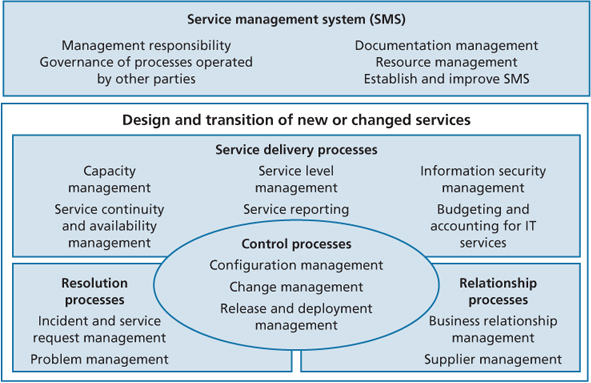
Figure 1.6 The ISO/IEC 20000 standard
The SMS is what establishes the necessary governance framework and accountability to effectively implement a sustainable service management programme. Figure 1.6 depicts the ISO/IEC 20000 standard, including the five key elements of the SMS. These are:
- Management responsibility
- Governance of processes operated by other parties
- Documentation management
- Resource management
- Establish and improve the SMS.
The first four areas are discussed in this chapter.
1.5.1Management responsibility
1.5.1.1 Management commitment
Management responsibility and accountability shall be demonstrated through the active engagement and commitment of executive management for the SMS that will enable the successful execution of the service strategy for the organization. This is demonstrated through the effective implementation of a holistic communication and organizational change programme which actively demonstrates that executive management is doing what it says it can do (‘walking the talk’).
1.5.1.2 Service management policy
Executive management shall establish an appropriate service management policy that commits to meeting the service requirements promised to the customer and includes a commitment to continually improve the SMS and underlying services.
1.5.1.3 Authority, responsibility and communication
Executive management shall make sure that clear roles and responsibilities are defined and managed and that the appropriate documented procedures of communication are established and executed amongst the SMS roles.
1.5.1.4 Management representative
Executive management shall designate a champion within the organization to lead and implement the service management programme through the effective execution of the SMS. This designee is usually someone at a director level with the authority and accountability in driving service and process improvements to meet business objectives. The designee shall also be responsible for making sure that the SMS is fulfilling current business requirements and shall be responsible for reporting the current performance and improvement opportunities of the SMS to executive management.
1.5.2Governance of processes operated by other parties
The organization shall demonstrate effective management of other parties that are part of service delivery. Other parties can be an internal provider, a customer or an external supplier/vendor. The organization needs to leverage the service level management process within ITIL and ISO/IEC 20000 when managing and reporting on the performance of internal providers and the customer. The organization needs to leverage the supplier management process within ITIL and ISO/IEC 20000 when managing and reporting on the performance of external suppliers/vendors. It is imperative that the organization also identifies what role the parties play in process execution and the interfaces between the parties and processes responsible for service delivery to the organization. In addition, all process improvements shall be systematically planned and prioritized amongst the parties to best support the business needs of the organization.
1.5.3Documentation management
1.5.3.1 Establish and maintain documents
Documents are evidence of intention and the service provider shall be responsible for establishing and maintaining these documents to provide effective planning, operation and control of the SMS. Documents of evidence shall include:
- Service management policy and objectives
- Service management plan
- Process-specific policies and plans
- Service catalogue
- Service level agreements (SLAs)
- Service management processes
- Procedures and records that support service management processes
- Additional pertinent documents, including external documents that assist the service provider in the effective execution of the SMS and the delivery of services.
1.5.3.2 Control of documents
An effective control mechanism shall be established for required documents to support the SMS. A record is a specific type of document that needs to be properly controlled within the SMS.
A documented procedure shall be established to clarify the authorities and responsibilities to define the controls to:
- Create and approve a document prior to issuing
- Communicate to pertinent parties about the new or changed documents
- Review and maintain documents
- Identify changes that are made to documents and track revisions of the changes
- Provide access to the applicable and most current versions of documents
- Make sure documents are easily identifiable and legible
- Make sure external documents are identified and that controlled distribution occurs for external documents
- Prevent use of obsolete documents by properly archiving them with appropriate identification.
1.5.3.3 Control of records
Records are evidence of activity. Evidence of records demonstrates the proper execution of the SMS and conformance to established requirements. A documented procedure shall be established for the identification, storage, protection, access, retention and disposal of records. Records need to be easily identifiable, accessible and legible.
1.5.4Resource management
1.5.4.1 Provision of resources
The service provider shall determine and provide the correct mix of information, people, technical and financial resources to effectively establish, implement and maintain the SMS and the services. These resources shall also support CSI efforts for the SMS. More importantly, these resources will focus on enhancing customer satisfaction by delivering services that fulfil service requirements.
The service provider personnel executing the work to support the SMS shall possess the appropriate skills, experience, training and education. The service provider shall:
- Determine the required competency for the personnel
- Provide training as necessary
- Evaluate the effectiveness of actions taken
- Ensure that personnel are aware of how they contribute to the achievement of service management objectives to meet service requirements
- Maintain the appropriate records for skills, experience, training and education.
